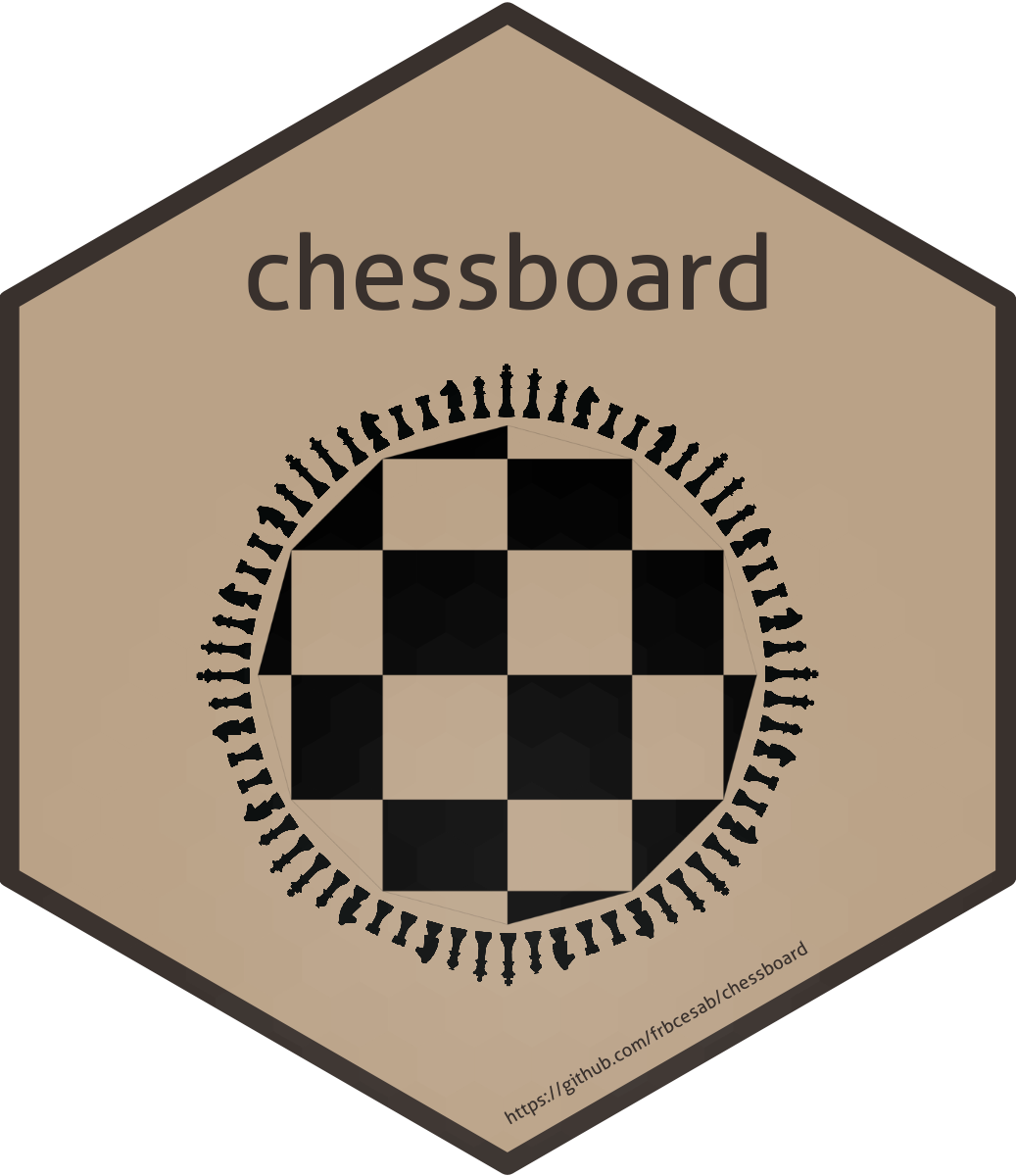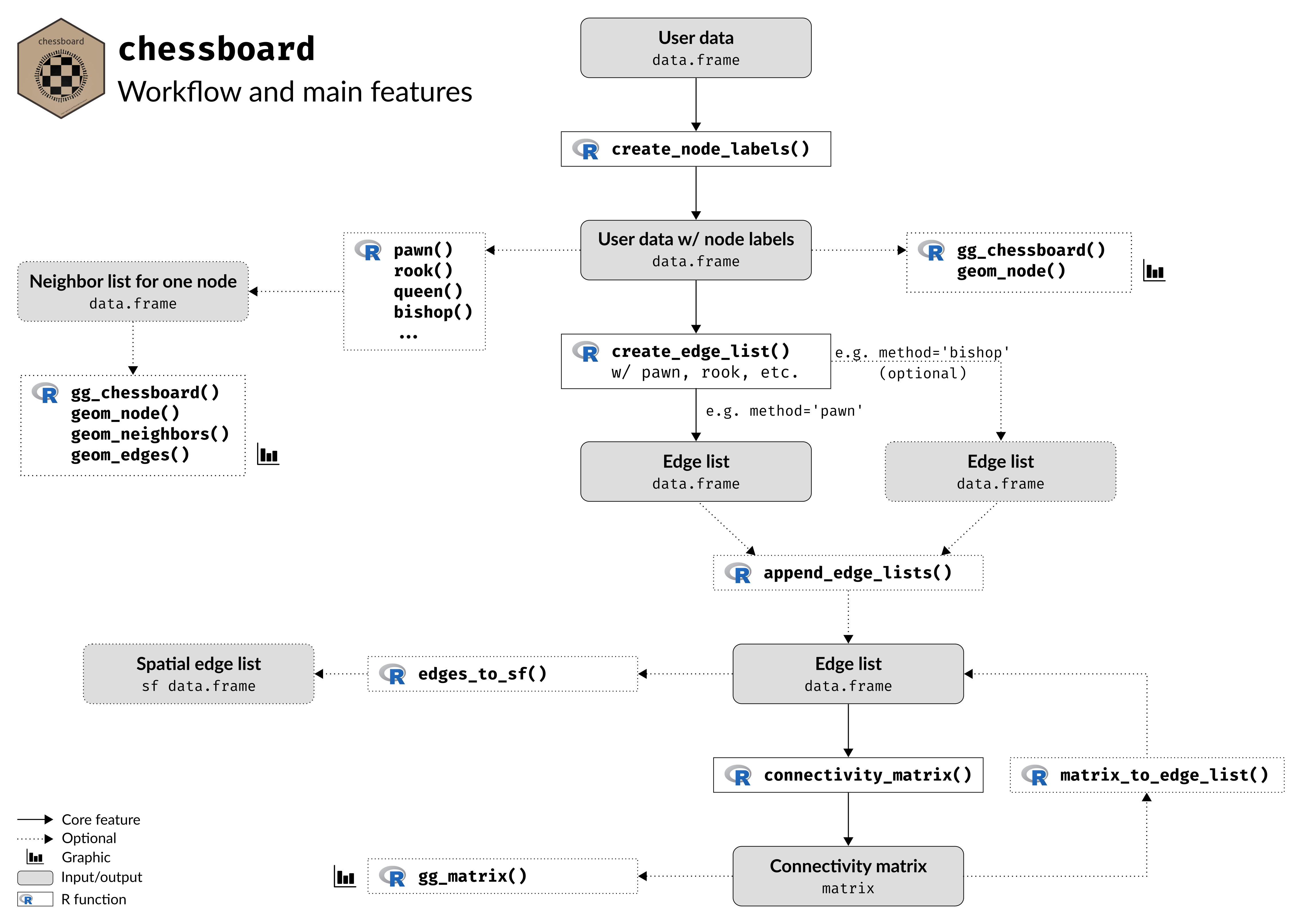
The hardware and bandwidth for this mirror is donated by METANET, the Webhosting and Full Service-Cloud Provider.
If you wish to report a bug, or if you are interested in having us mirror your free-software or open-source project, please feel free to contact us at mirror[@]metanet.ch.

• Overview
•
Features
•
Installation
•
Get started
•
Long-form documentations
•
Citation
•
Contributing
•
Acknowledgments
•
References
The package chessboard provides functions to work with
directed (asymmetric) and undirected
(symmetric) spatial (or non-spatial) networks. It
implements different methods to detect neighbors, all based on the chess
game (it goes beyond the rook and the queen) to create complex
connectivity scenarios.
chessboard can handle spatial networks, but it does not
explicitly use geographical coordinates to find neighbors (it is not
based on spatial distance). Instead, it identifies neighbors according
to node labels (i.e. the node position on a
two-dimension chessboard) and a specific method (pawn, fool, rook,
bishop, knight, queen, wizard, etc.).
It implements the following rules to detect neighbors and create edges:
the degree of neighborhood: the number of adjacent nodes that will be used to create direct edges.
the orientation of neighborhood: can neighbors be detected horizontally, vertically and/or diagonally?
the direction of neighborhood: does the sampling has a main direction? This can be particularly relevant for directed networks (e.g. rivers).
The main purpose of chessboard is to create various
network objects, including:
chessboard also provides different plotting functions
(all based on the ggplot2
package):
gg_matrix()
plots a (connectivity) matrixgg_chessboard()
plots the sampling as a chessboardRead the Visualization tools vignette for further details.

Finally, the package can also produce objects that will be used later
in Moran’s Eigenvector Maps (MEM, Dray et
al. 2006) and Asymetric Eigenvector Maps (AEM, Blanchet
et al. 2008), methods available in the package adespatial
(Dray et al. 2023):
The package is not yet published on the CRAN but you can install the development version from GitHub with:
# install.packages("remotes")
remotes::install_github("frbcesab/chessboard")Then you can attach the package chessboard:
library("chessboard")For an overview of the main features of chessboard,
please read the Get
started vignette.
chessboard provides three vignettes to learn more about
the package:
chessboard to detect neighborschessboardPlease cite chessboard as:
Casajus N, Rievrs Borges E, Tabacchi E, Fried G & Mouquet N (2023)
chessboard: An R package for creating network connections based on chess moves. Journal of Open Source Software, 8, 5753. https://doi.org/10.21105/joss.05753.
All types of contributions are encouraged and valued. For more information, check out our Contributor Guidelines.
Please note that the chessboard project is released with
a Contributor
Code of Conduct. By contributing to this project, you agree to abide
by its terms.
This package has been developed for the FRB-CESAB working group Bridge that aims to better understand the role of local and regional environmental factors in shaping the taxonomic and functional diversity of plant communities established along river corridors, roadside corridors and cultivated field margins.
Blanchet FG, Legendre P & Borcard D (2008) Modelling directional spatial processes in ecological data. Ecological Modelling, 215, 325-336. doi: 10.1016/j.ecolmodel.2008.04.001.
Csardi G & Nepusz T (2006) The igraph software package for complex network research. InterJournal, Complex Systems, 1695, 1-9. https://igraph.org/.
Dray S, Bauman D, Blanchet G et al. (2023)
adespatial: Multivariate Multiscale Spatial Analysis. R
package version 0.3-21, https://CRAN.R-project.org/package=adespatial.
Dray S, Legendre P & Peres-Neto PR (2006) Spatial modeling: a comprehensive framework for principal coordinate analysis of neighbor matrices (PCNM). Ecological Modelling, 196: 483–93. doi: 10.1016/j.ecolmodel.2006.02.015.
These binaries (installable software) and packages are in development.
They may not be fully stable and should be used with caution. We make no claims about them.